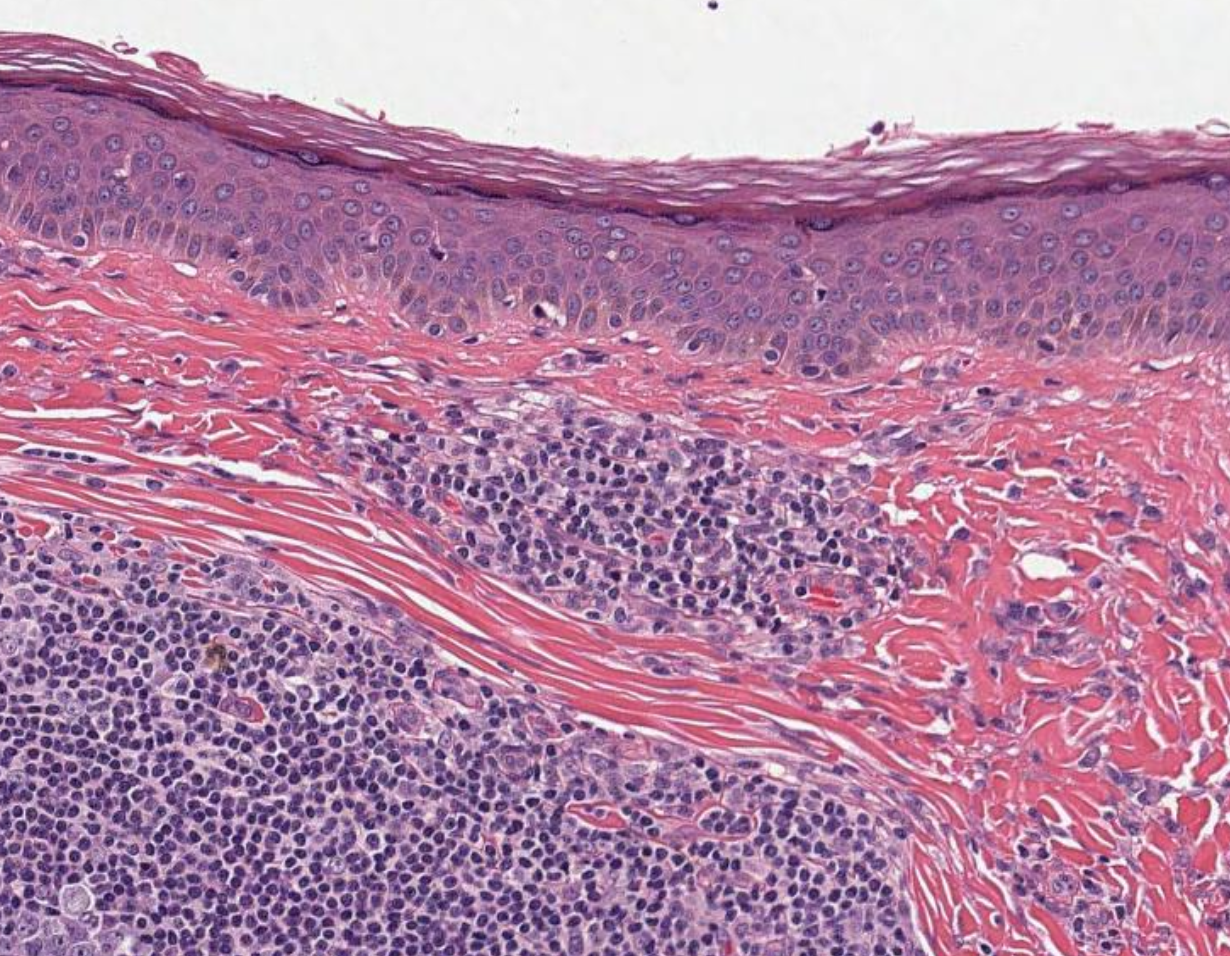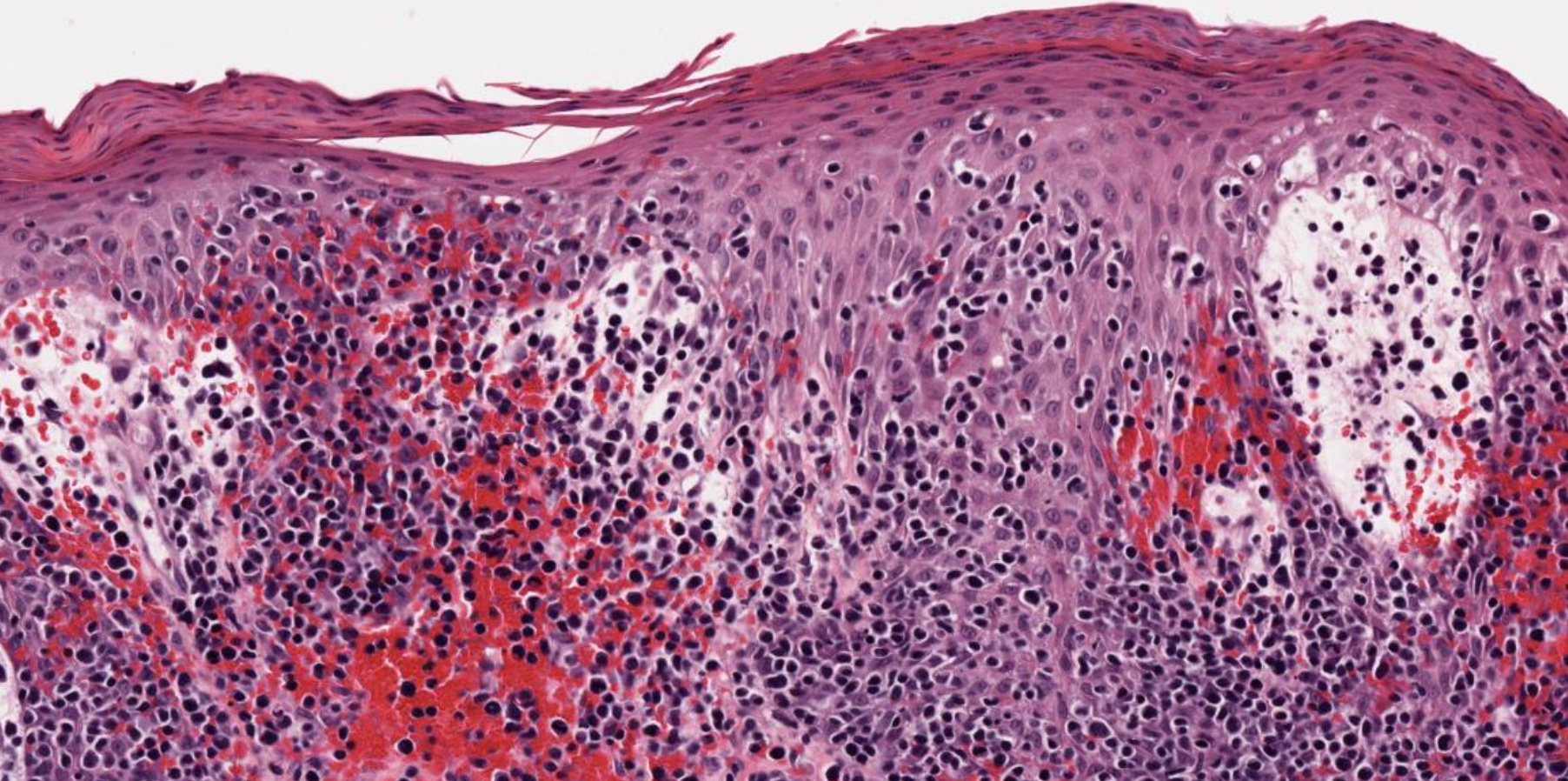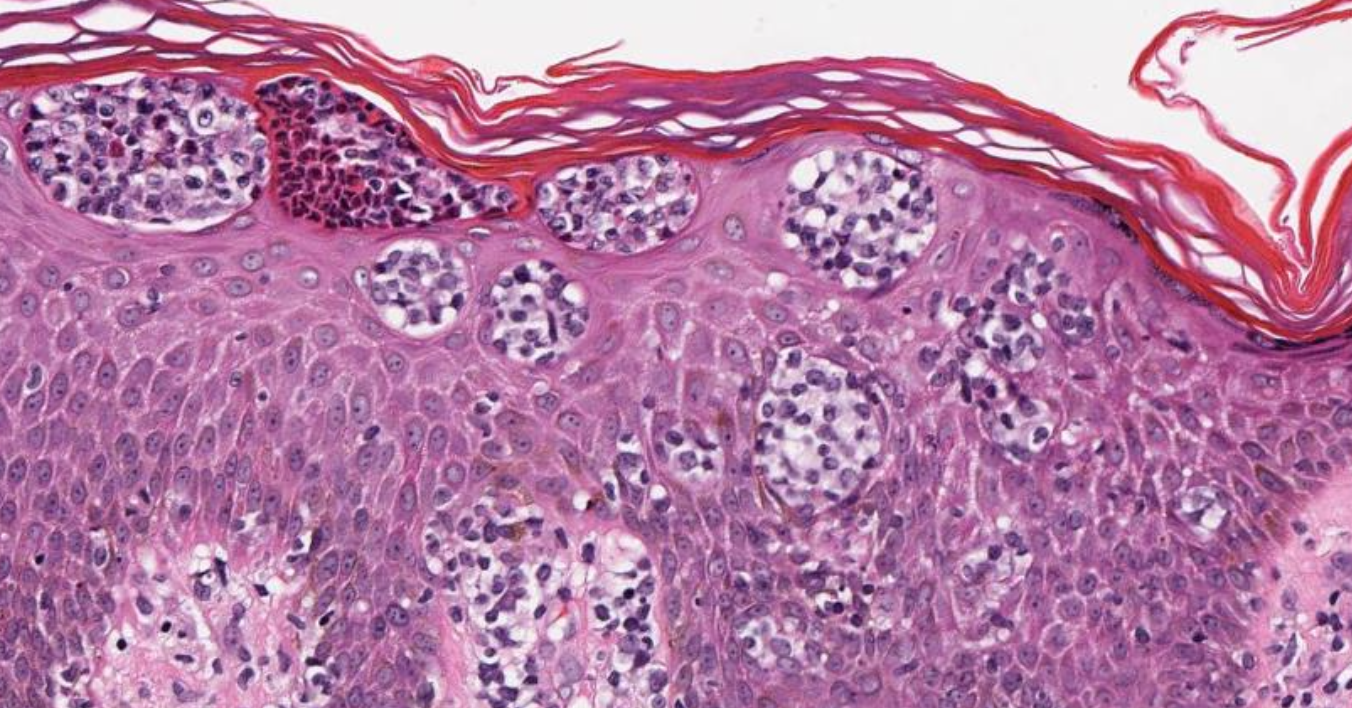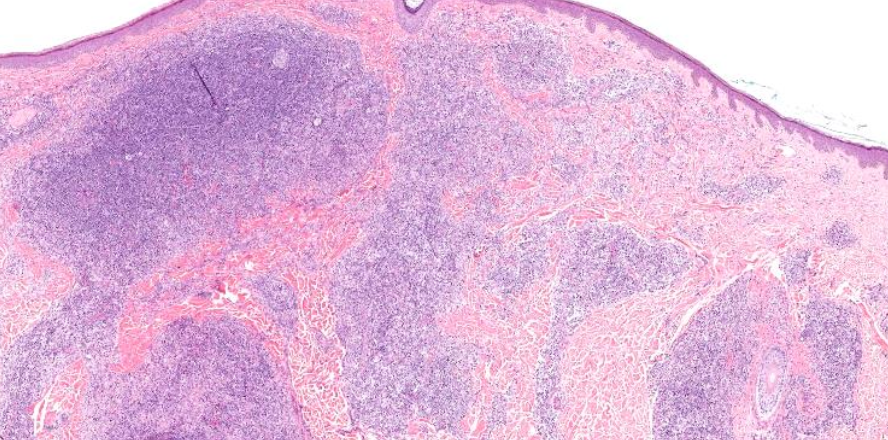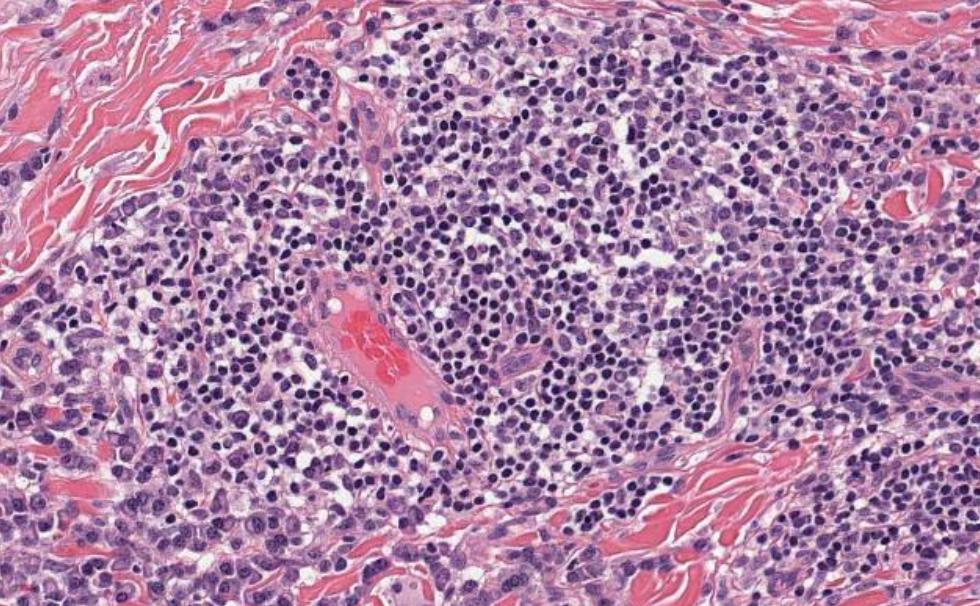[1]
Kempf W,Zimmermann AK,Mitteldorf C, Cutaneous lymphomas-An update 2019. Hematological oncology. 2019 Jun;
[PubMed PMID: 31187534]
[2]
Willemze R,Cerroni L,Kempf W,Berti E,Facchetti F,Swerdlow SH,Jaffe ES, The 2018 update of the WHO-EORTC classification for primary cutaneous lymphomas. Blood. 2019 Apr 18;
[PubMed PMID: 30635287]
[3]
Specht L,Skov L, Cutaneous Lymphomas. Clinical oncology (Royal College of Radiologists (Great Britain)). 2019 Nov;
[PubMed PMID: 31405542]
[4]
Willemze R,Jaffe ES,Burg G,Cerroni L,Berti E,Swerdlow SH,Ralfkiaer E,Chimenti S,Diaz-Perez JL,Duncan LM,Grange F,Harris NL,Kempf W,Kerl H,Kurrer M,Knobler R,Pimpinelli N,Sander C,Santucci M,Sterry W,Vermeer MH,Wechsler J,Whittaker S,Meijer CJ, WHO-EORTC classification for cutaneous lymphomas. Blood. 2005 May 15;
[PubMed PMID: 15692063]
[5]
Criscione VD,Weinstock MA, Incidence of cutaneous T-cell lymphoma in the United States, 1973-2002. Archives of dermatology. 2007 Jul;
[PubMed PMID: 17638728]
[6]
Agar NS,Wedgeworth E,Crichton S,Mitchell TJ,Cox M,Ferreira S,Robson A,Calonje E,Stefanato CM,Wain EM,Wilkins B,Fields PA,Dean A,Webb K,Scarisbrick J,Morris S,Whittaker SJ, Survival outcomes and prognostic factors in mycosis fungoides/Sézary syndrome: validation of the revised International Society for Cutaneous Lymphomas/European Organisation for Research and Treatment of Cancer staging proposal. Journal of clinical oncology : official journal of the American Society of Clinical Oncology. 2010 Nov 1;
[PubMed PMID: 20855822]
Level 1 (high-level) evidence
[7]
Wohlmuth-Wieser I, Primary cutaneous T-cell lymphomas in childhood and adolescence. Journal der Deutschen Dermatologischen Gesellschaft = Journal of the German Society of Dermatology : JDDG. 2021 Apr;
[PubMed PMID: 33861015]
[8]
Goyal A,O'Leary D,Goyal K,Patel K,Pearson D,Janakiram M, Cutaneous T-cell lymphoma is associated with increased risk of lymphoma, melanoma, lung cancer, and bladder cancer. Journal of the American Academy of Dermatology. 2021 Dec;
[PubMed PMID: 32822803]
[9]
Larocca C,Kupper T, Mycosis Fungoides and Sézary Syndrome: An Update. Hematology/oncology clinics of North America. 2019 Feb;
[PubMed PMID: 30497668]
[11]
Oschlies I,Wehkamp U, Cutaneous B cell lymphomas: standards in diagnostic and clinical work-up. Hints, pitfalls and recent advances. Histopathology. 2022 Jan;
[PubMed PMID: 34958501]
Level 3 (low-level) evidence
[12]
Molloy K,Jonak C,Woei-A-Jin FJSH,Guenova E,Busschots AM,Bervoets A,Hauben E,Knobler R,Porkert S,Fassnacht C,Cowan R,Papadavid E,Beylot-Barry M,Berti E,Alberti Violetti S,Estrach T,Matin R,Akilov O,Vakeva L,Prince M,Bates A,Bayne M,Wachsmuch R,Wehkamp U,Marschalko M,Servitje O,Turner D,Weatherhead S,Wobser M,Sanches JA,McKay P,Klemke D,Peng C,Howles A,Yoo J,Evison F,Scarisbrick J, Characteristics associated with significantly worse quality of life in mycosis fungoides/Sézary syndrome from the Prospective Cutaneous Lymphoma International Prognostic Index (PROCLIPI) study. The British journal of dermatology. 2020 Mar;
[PubMed PMID: 31049926]
Level 2 (mid-level) evidence
[13]
Bhat TS,Herbosa CM,Rosenberg AR,Sogade O,Jeffe DB,Mehta-Shah N,Semenov YR,Musiek AC, Current measures are not sufficient: an interview-based qualitative assessment of quality of life in cutaneous T-cell lymphoma. The British journal of dermatology. 2021 Feb;
[PubMed PMID: 32510571]
Level 2 (mid-level) evidence
[14]
Jonak C,Porkert S,Oerlemans S,Papadavid E,Molloy K,Lehner-Baumgartner E,Cozzio A,Efficace F,Scarisbrick J, Health-related Quality of Life in Cutaneous Lymphomas: Past, Present and Future. Acta dermato-venereologica. 2019 Jun 1;
[PubMed PMID: 30868169]
Level 2 (mid-level) evidence
[15]
Elenitoba-Johnson KS,Wilcox R, A new molecular paradigm in mycosis fungoides and Sézary syndrome. Seminars in diagnostic pathology. 2017 Jan;
[PubMed PMID: 28024703]
[16]
Jones CL,Degasperi A,Grandi V,Amarante TD,Genomics England Research Consortium.,Mitchell TJ,Nik-Zainal S,Whittaker SJ, Spectrum of mutational signatures in T-cell lymphoma reveals a key role for UV radiation in cutaneous T-cell lymphoma. Scientific reports. 2021 Feb 17;
[PubMed PMID: 33597573]
[17]
Park J,Daniels J,Wartewig T,Ringbloom KG,Martinez-Escala ME,Choi S,Thomas JJ,Doukas PG,Yang J,Snowden C,Law C,Lee Y,Lee K,Zhang Y,Conran C,Tegtmeyer K,Mo SH,Pease DR,Jothishankar B,Kwok PY,Abdulla FR,Pro B,Louissaint A,Boggon TJ,Sosman J,Guitart J,Rao D,Ruland J,Choi J, Integrated genomic analyses of cutaneous T-cell lymphomas reveal the molecular bases for disease heterogeneity. Blood. 2021 Oct 7;
[PubMed PMID: 34115827]
[18]
Miyashiro D,Sanches JA, Cutaneous manifestations of adult T-cell leukemia/lymphoma. Seminars in diagnostic pathology. 2020 Mar;
[PubMed PMID: 31387753]
[19]
Hristov AC,Tejasvi T,A Wilcox R, Cutaneous T-cell lymphomas: 2021 update on diagnosis, risk-stratification, and management. American journal of hematology. 2021 Oct 1;
[PubMed PMID: 34297414]
[20]
Jahan-Tigh RR,Huen AO,Lee GL,Pozadzides JV,Liu P,Duvic M, Hydrochlorothiazide and cutaneous T cell lymphoma: prospective analysis and case series. Cancer. 2013 Feb 15;
[PubMed PMID: 22952039]
Level 2 (mid-level) evidence
[21]
Pease DR,Martinez-Escala ME,Jimenez J,Guitart J,West DP,Nardone B, Cutaneous T-cell lymphoma after chronic exposure to hydrochlorothiazide: pharmacovigilance analysis from the RADAR (Research on Adverse Drug events And Reports) Program. Journal of the European Academy of Dermatology and Venereology : JEADV. 2021 Feb;
[PubMed PMID: 33480442]
[22]
Dumont M,Battistella M,Ram-Wolff C,Bagot M,de Masson A, Diagnosis and Treatment of Primary Cutaneous B-Cell Lymphomas: State of the Art and Perspectives. Cancers. 2020 Jun 8;
[PubMed PMID: 32521744]
Level 3 (low-level) evidence
[23]
Bogle MA,Riddle CC,Triana EM,Jones D,Duvic M, Primary cutaneous B-cell lymphoma. Journal of the American Academy of Dermatology. 2005 Sep;
[PubMed PMID: 16112357]
[24]
Mo XL,Zhou MY,Ye QR, Primary cutaneous Epstein-Barr virus-positive diffuse large B-cell lymphoma, not otherwise specified, in a nonimmunocompromised young man: A case report. Journal of cutaneous pathology. 2020 Apr;
[PubMed PMID: 31658378]
Level 3 (low-level) evidence
[25]
Monari P,Farisoglio C,Calzavara Pinton PG, Borrelia burgdorferi-associated primary cutaneous marginal-zone B-cell lymphoma: a case report. Dermatology (Basel, Switzerland). 2007;
[PubMed PMID: 17823520]
Level 3 (low-level) evidence
[26]
Vermeesch J,Ramirez J,Lafond A, Primary cutaneous Epstein-Barr virus-positive diffuse large B-cell lymphoma: a rare and aggressive cutaneous lymphoma. Cutis. 2018 Dec;
[PubMed PMID: 30657800]
[28]
Alsayyah A, Is it mycosis fungoides? A comprehensive guide to reaching the diagnosis and avoiding common pitfalls. Annals of diagnostic pathology. 2020 Aug;
[PubMed PMID: 32554312]
[29]
Miyagaki T, Diagnosis and prognostic stratification of cutaneous lymphoma. The Journal of dermatology. 2022 Feb;
[PubMed PMID: 34346516]
[30]
Bakar O,Seçkin D,Demirkesen C,Baykal C,Büyükbabani N, Two Clinically Unusual Cases of Folliculotropic Mycosis Fungoides: One with and the Other without Syringotropism. Annals of dermatology. 2014 Jun;
[PubMed PMID: 24966641]
Level 3 (low-level) evidence
[31]
Gerami P,Guitart J, The spectrum of histopathologic and immunohistochemical findings in folliculotropic mycosis fungoides. The American journal of surgical pathology. 2007 Sep;
[PubMed PMID: 17721200]
[32]
Yao L,Yu Y,Guo Y,Li SS, Folliculotropic Mycosis Fungoides With CD30 Large-Cell Transformation. The American journal of the medical sciences. 2018 Nov;
[PubMed PMID: 30205898]
[33]
Stahly S,Manway M,Lin CC,Sukpraprut-Braaten S, Pagetoid Reticulosis: A Rare Dermatologic Malignancy Presenting in a Middle-Aged Female. Cureus. 2021 Oct;
[PubMed PMID: 34754679]
[34]
Haghighi B,Smoller BR,LeBoit PE,Warnke RA,Sander CA,Kohler S, Pagetoid reticulosis (Woringer-Kolopp disease): an immunophenotypic, molecular, and clinicopathologic study. Modern pathology : an official journal of the United States and Canadian Academy of Pathology, Inc. 2000 May;
[PubMed PMID: 10824921]
[35]
Lu D,Patel KA,Duvic M,Jones D, Clinical and pathological spectrum of CD8-positive cutaneous T-cell lymphomas. Journal of cutaneous pathology. 2002 Sep;
[PubMed PMID: 12207740]
[36]
Goldsztajn KO,Moritz Trope B,Ribeiro Lenzi ME,Cuzzi T,Ramos-E-Silva M, Granulomatous slack skin. Histopathology diagnosis preceding clinical manifestations by 12 years. Journal of dermatological case reports. 2012 Dec 31;
[PubMed PMID: 23329989]
Level 3 (low-level) evidence
[37]
Shah A,Safaya A, Granulomatous slack skin disease: a review, in comparison with mycosis fungoides. Journal of the European Academy of Dermatology and Venereology : JEADV. 2012 Dec;
[PubMed PMID: 22435618]
[38]
Kempf W,Ostheeren-Michaelis S,Paulli M,Lucioni M,Wechsler J,Audring H,Assaf C,Rüdiger T,Willemze R,Meijer CJ,Berti E,Cerroni L,Santucci M,Hallermann C,Berneburg M,Chimenti S,Robson A,Marschalko M,Kazakov DV,Petrella T,Fraitag S,Carlotti A,Courville P,Laeng H,Knobler R,Golling P,Dummer R,Burg G,Cutaneous Lymphoma Histopathology Task Force Group of the European Organization for Research and Treatment of Cancer., Granulomatous mycosis fungoides and granulomatous slack skin: a multicenter study of the Cutaneous Lymphoma Histopathology Task Force Group of the European Organization For Research and Treatment of Cancer (EORTC). Archives of dermatology. 2008 Dec;
[PubMed PMID: 19075143]
Level 2 (mid-level) evidence
[39]
Burg G,Kempf W,Cozzio A,Feit J,Willemze R,S Jaffe E,Dummer R,Berti E,Cerroni L,Chimenti S,Diaz-Perez JL,Grange F,Harris NL,Kazakov DV,Kerl H,Kurrer M,Knobler R,Meijer CJ,Pimpinelli N,Ralfkiaer E,Russell-Jones R,Sander C,Santucci M,Sterry W,Swerdlow SH,Vermeer MH,Wechsler J,Whittaker S, WHO/EORTC classification of cutaneous lymphomas 2005: histological and molecular aspects. Journal of cutaneous pathology. 2005 Nov;
[PubMed PMID: 16293178]
[40]
Motta LMD,Soares CT,Nakandakari S,Silva GVD,Nigro MHMF,Brandão LSG, Granulomatous slack skin: a rare subtype of mycosis fungoides. Anais brasileiros de dermatologia. 2017 Sep-Oct;
[PubMed PMID: 29166509]
[41]
Bittencourt AL,Barbosa HS,Vieira MD,Farré L, Adult T-cell leukemia/lymphoma (ATL) presenting in the skin: clinical, histological and immunohistochemical features of 52 cases. Acta oncologica (Stockholm, Sweden). 2009;
[PubMed PMID: 19165640]
Level 3 (low-level) evidence
[42]
Wang J,Hasui K,Utsunomiya A,Jia X,Matsuyama T,Murata F, Association of high proliferation in adult T-cell leukemia cells with apoptosis, and expression of p53 protein in acute type ATL. Journal of clinical and experimental hematopathology : JCEH. 2008 Apr;
[PubMed PMID: 18434687]
[43]
Brown RA,Fernandez-Pol S,Kim J, Primary cutaneous anaplastic large cell lymphoma. Journal of cutaneous pathology. 2017 Jun;
[PubMed PMID: 28342276]
[44]
Moodley N,Nombona P,Mosam A, Primary Cutaneous Anaplastic Large-Cell Lymphoma. Dermatopathology (Basel, Switzerland). 2019 Apr-Jun;
[PubMed PMID: 31700858]
[45]
Martinez-Cabriales SA,Walsh S,Sade S,Shear NH, Lymphomatoid papulosis: an update and review. Journal of the European Academy of Dermatology and Venereology : JEADV. 2020 Jan;
[PubMed PMID: 31494989]
[46]
Sánchez-Romero C,Bologna-Molina R,Paes de Almeida O,Santos-Silva AR,Prado-Ribeiro AC,Brandão TB,Carlos R, Extranodal NK/T cell lymphoma, nasal type: An updated overview. Critical reviews in oncology/hematology. 2021 Mar;
[PubMed PMID: 33493634]
Level 3 (low-level) evidence
[47]
Chen Z,Liu W,Zhang W,Ye Y,Guan P,Gao L,Zhao S, Chronic Active Epstein-Barr Virus Infection of T/NK-Cell Type Mimicking Classic Hodgkin Lymphoma: Clinicopathologic and Genetic Features of 8 Cases Supporting a Variant With
[PubMed PMID: 31305266]
Level 3 (low-level) evidence
[48]
Luo H,Yuan Z,Qin B, Case Report: Chronic Active Epstein-Barr Virus Infection With Subcutaneous Nodules and Systemic Damage. Frontiers in medicine. 2022;
[PubMed PMID: 35433738]
Level 2 (mid-level) evidence
[49]
Rubio-Gonzalez B,Zain J,Rosen ST,Querfeld C, Clinical manifestations and pathogenesis of cutaneous lymphomas: current status and future directions. British journal of haematology. 2017 Jan;
[PubMed PMID: 27782301]
Level 3 (low-level) evidence
[50]
Aderhold K,Carpenter L,Brown K,Donato A, Primary Cutaneous Peripheral T-Cell Lymphoma Not Otherwise Specified: A Rapidly Progressive Variant of Cutaneous T-Cell Lymphoma. Case reports in oncological medicine. 2015;
[PubMed PMID: 26380134]
Level 3 (low-level) evidence
[52]
Hristov AC, Primary cutaneous diffuse large B-cell lymphoma, leg type: diagnostic considerations. Archives of pathology
[PubMed PMID: 22849734]
[53]
Mukherjee A,Ibrahim IF, Intravascular large B-cell lymphoma: an elusive diagnosis with challenging management. The Journal of community and supportive oncology. 2018;
[PubMed PMID: 32984438]
[54]
Dewar R,Andea AA,Guitart J,Arber DA,Weiss LM, Best practices in diagnostic immunohistochemistry: workup of cutaneous lymphoid lesions in the diagnosis of primary cutaneous lymphoma. Archives of pathology
[PubMed PMID: 25724031]
[55]
Sokołowska-Wojdyło M,Olek-Hrab K,Ruckemann-Dziurdzińska K, Primary cutaneous lymphomas: diagnosis and treatment. Postepy dermatologii i alergologii. 2015 Oct;
[PubMed PMID: 26759546]
[56]
Cetinözman F,Jansen PM,Vermeer MH,Willemze R, Differential expression of programmed death-1 (PD-1) in Sézary syndrome and mycosis fungoides. Archives of dermatology. 2012 Dec;
[PubMed PMID: 23247480]
[57]
Hurabielle C,Thonnart N,Ram-Wolff C,Sicard H,Bensussan A,Bagot M,Marie-Cardine A, Usefulness of KIR3DL2 to Diagnose, Follow-Up, and Manage the Treatment of Patients with Sézary Syndrome. Clinical cancer research : an official journal of the American Association for Cancer Research. 2017 Jul 15;
[PubMed PMID: 28119365]
[58]
Graham RL,Burch M,Krause JR, Adult T-cell leukemia/lymphoma. Proceedings (Baylor University. Medical Center). 2014 Jul;
[PubMed PMID: 24982574]
[59]
Yamaguchi K,Watanabe T, Human T lymphotropic virus type-I and adult T-cell leukemia in Japan. International journal of hematology. 2002 Aug;
[PubMed PMID: 12430931]
[60]
Gru AA,Jaffe ES, Cutaneous EBV-related lymphoproliferative disorders. Seminars in diagnostic pathology. 2017 Jan;
[PubMed PMID: 27988064]
[61]
Raess PW,Bagg A, The role of molecular pathology in the diagnosis of cutaneous lymphomas. Pathology research international. 2012;
[PubMed PMID: 23213624]
[62]
Damsky WE,Choi J, Genetics of Cutaneous T Cell Lymphoma: From Bench to Bedside. Current treatment options in oncology. 2016 Jul;
[PubMed PMID: 27262707]
[63]
Jung JM,Lim DJ,Won CH,Chang SE,Lee MW,Lee WJ, Mycosis Fungoides in Children and Adolescents: A Systematic Review. JAMA dermatology. 2021 Apr 1;
[PubMed PMID: 33656521]
Level 1 (high-level) evidence
[64]
Wu JH,Cohen BA,Sweren RJ, Mycosis fungoides in pediatric patients: Clinical features, diagnostic challenges, and advances in therapeutic management. Pediatric dermatology. 2020 Jan;
[PubMed PMID: 31630432]
Level 3 (low-level) evidence
[65]
Mitteldorf C,Stadler R,Sander CA,Kempf W, Folliculotropic mycosis fungoides. Journal der Deutschen Dermatologischen Gesellschaft = Journal of the German Society of Dermatology : JDDG. 2018 May;
[PubMed PMID: 29726638]
[66]
Torre-Castro J,Carrasco Santos L,Rodríguez-Pinilla SM,Requena L, Pagetoid reticulosis in a 13-year old female. A unique immunohistochemical profile. Journal of cutaneous pathology. 2020 May;
[PubMed PMID: 31785005]
[67]
Carlesimo M,Tammaro A,Cox C,Mari E,Fidanza L,Narcisi A,Cacchi C,Camplone G, A Case of Ketron-Goodman Disease. Case reports in dermatology. 2009 Sep 12;
[PubMed PMID: 20652112]
Level 3 (low-level) evidence
[68]
Wilcox RA, Cutaneous T-cell lymphoma: 2011 update on diagnosis, risk-stratification, and management. American journal of hematology. 2011 Nov;
[PubMed PMID: 21990092]
[69]
Berg S,Villasenor-Park J,Haun P,Kim EJ, Multidisciplinary Management of Mycosis Fungoides/Sézary Syndrome. Current hematologic malignancy reports. 2017 Jun;
[PubMed PMID: 28540671]
[70]
Cook LB,Fuji S,Hermine O,Bazarbachi A,Ramos JC,Ratner L,Horwitz S,Fields P,Tanase A,Bumbea H,Cwynarski K,Taylor G,Waldmann TA,Bittencourt A,Marcais A,Suarez F,Sibon D,Phillips A,Lunning M,Farid R,Imaizumi Y,Choi I,Ishida T,Ishitsuka K,Fukushima T,Uchimaru K,Takaori-Kondo A,Tokura Y,Utsunomiya A,Matsuoka M,Tsukasaki K,Watanabe T, Revised Adult T-Cell Leukemia-Lymphoma International Consensus Meeting Report. Journal of clinical oncology : official journal of the American Society of Clinical Oncology. 2019 Mar 10;
[PubMed PMID: 30657736]
Level 3 (low-level) evidence
[71]
Hermine O,Ramos JC,Tobinai K, A Review of New Findings in Adult T-cell Leukemia-Lymphoma: A Focus on Current and Emerging Treatment Strategies. Advances in therapy. 2018 Feb;
[PubMed PMID: 29411267]
Level 3 (low-level) evidence
[72]
Gonçalves DU,Proietti FA,Ribas JG,Araújo MG,Pinheiro SR,Guedes AC,Carneiro-Proietti AB, Epidemiology, treatment, and prevention of human T-cell leukemia virus type 1-associated diseases. Clinical microbiology reviews. 2010 Jul;
[PubMed PMID: 20610824]
[74]
Leventaki V,Bhattacharyya S,Lim MS, Pathology and genetics of anaplastic large cell lymphoma. Seminars in diagnostic pathology. 2020 Jan;
[PubMed PMID: 31882178]
[75]
Lee WJ,Moon IJ,Lee SH,Won CH,Chang SE,Choi JH,Moon KC,Park CS,Huh J,Lee MW, Cutaneous anaplastic large-cell lymphoma (ALCL): A comparative clinical feature and survival outcome analysis of 52 cases according to primary tumor site. Journal of the American Academy of Dermatology. 2016 Jun;
[PubMed PMID: 26897385]
Level 2 (mid-level) evidence
[76]
Barete S,Francés C,Charlotte F,Barrou B,Leblond V,Dereure O, Fatal outcome of deep-penetrating lower limb primary cutaneous anaplastic large cell lymphomas in two immunocompromised patients. Acta dermato-venereologica. 2009 Nov;
[PubMed PMID: 19997696]
[77]
Sugaya M,Fujita H,Izutsu K,Oshima K,Takazawa Y,Ohmatsu H,Yoshimi A,Takahashi T,Kanda Y,Kurokawa M,Tamaki K,Sato S, Primary cutaneous anaplastic large cell lymphoma with leg involvement: a case report and review of 11 cases. The Journal of dermatology. 2011 Oct;
[PubMed PMID: 21434982]
Level 3 (low-level) evidence
[78]
Kempf W,Pfaltz K,Vermeer MH,Cozzio A,Ortiz-Romero PL,Bagot M,Olsen E,Kim YH,Dummer R,Pimpinelli N,Whittaker S,Hodak E,Cerroni L,Berti E,Horwitz S,Prince HM,Guitart J,Estrach T,Sanches JA,Duvic M,Ranki A,Dreno B,Ostheeren-Michaelis S,Knobler R,Wood G,Willemze R, EORTC, ISCL, and USCLC consensus recommendations for the treatment of primary cutaneous CD30-positive lymphoproliferative disorders: lymphomatoid papulosis and primary cutaneous anaplastic large-cell lymphoma. Blood. 2011 Oct 13;
[PubMed PMID: 21841159]
Level 3 (low-level) evidence
[79]
Cordel N,Tressières B,D'Incan M,Machet L,Grange F,Estève É,Dalac S,Ingen-Housz-Oro S,Bagot M,Beylot-Barry M,Joly P,French Study Group on Cutaneous Lymphoma., Frequency and Risk Factors for Associated Lymphomas in Patients With Lymphomatoid Papulosis. The oncologist. 2016 Jan;
[PubMed PMID: 26668250]
[80]
Sugeeth MT,Narayanan G,Jayasudha AV,Nair RA, Subcutaneous panniculitis-like T-cell lymphoma. Proceedings (Baylor University. Medical Center). 2017 Jan;
[PubMed PMID: 28127142]
[81]
Arai A, Chronic Active Epstein-Barr Virus Infection: The Elucidation of the Pathophysiology and the Development of Therapeutic Methods. Microorganisms. 2021 Jan 15;
[PubMed PMID: 33467742]
[82]
Fernandez-Pol S,Silva O,Natkunam Y, Defining the elusive boundaries of chronic active Epstein-Barr virus infection. Haematologica. 2018 Jun;
[PubMed PMID: 29866887]
[83]
Alberti-Violetti S,Maronese CA,Venegoni L,Merlo V,Berti E, Primary Cutaneous Gamma-Delta T Cell Lymphomas: A Case Series and Overview of the Literature. Dermatopathology (Basel, Switzerland). 2021 Nov 17;
[PubMed PMID: 34842638]
Level 2 (mid-level) evidence
[84]
Nofal A,Abdel-Mawla MY,Assaf M,Salah E, Primary cutaneous aggressive epidermotropic CD8 T-cell lymphoma: proposed diagnostic criteria and therapeutic evaluation. Journal of the American Academy of Dermatology. 2012 Oct;
[PubMed PMID: 22226429]
[85]
Gru AA,Wick MR,Eid M, Primary cutaneous CD4 small/medium T-cell lymphoproliferative disorder-clinical and histopathologic features, differential diagnosis, and treatment. Seminars in cutaneous medicine and surgery. 2018 Mar;
[PubMed PMID: 29719019]
[86]
Hathuc VM,Hristov AC,Smith LB, Primary Cutaneous Acral CD8{sup} {/sup} T-Cell Lymphoma. Archives of pathology
[PubMed PMID: 29072952]
[88]
Ikeda T,Gion Y,Yoshino T,Sato Y, A review of EBV-positive mucocutaneous ulcers focusing on clinical and pathological aspects. Journal of clinical and experimental hematopathology : JCEH. 2019;
[PubMed PMID: 31257347]
[89]
Goodlad JR,Cerroni L,Swerdlow SH, Recent advances in cutaneous lymphoma-implications for current and future classifications. Virchows Archiv : an international journal of pathology. 2022 Oct 24
[PubMed PMID: 36278991]
Level 3 (low-level) evidence

